Reserve Defenders Keep Watch
By Maj. Jon Quinlan, 507th Air Refueling Wing Public Affairs, Published April 24, 2017
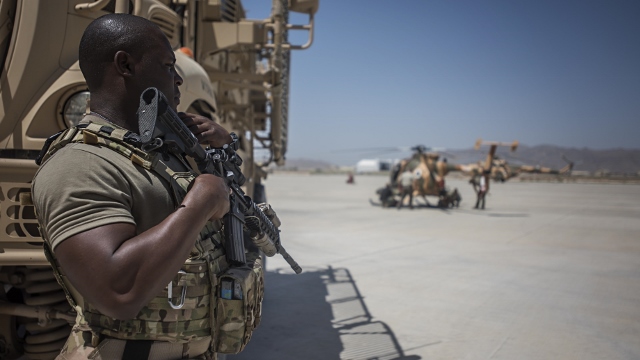
Senior Airman Micheal Thomas, 738th Air Expeditionary Advisory Group security forces member, provides armed overwatch for contractors and air advisors performing maintenance on an Afghan Air Force MD-530 Light Attack Helicopter, April 16, 2017, at Kandahar Air Wing, Afghanistan. Thomas is deployed with other Citizen Airmen from the 507th Security Forces Squadron, Tinker Air Force Base, Okla. (U.S. Air Force photo/Staff Sgt. Katherine Spessa)
TINKER AIR FORCE BASE, Okla. -- A group of Citizen Airmen from the 507th Security Forces Squadron here deployed March 31 to Kandahar Air Base, Afghanistan, to support the Afghan Air Force in their fight against insurgents in support of NATO’s Resolute Support mission.
For the next six months, the team of Reserve defenders will be part of a Fly Away Security Team while in Afghanistan. Air Force FAST teams are made up of Security Forces Airmen who travel with aircraft to provide extra security around unsecured foreign airfields.
As a civilian, Senior Airman Casey Jardot of the 507th SFS is a research technician at an oil and gas company. This is his second deployment. He left the Marine Corps to join the Air Force Reserve, and said he is excited to go downrange to perform a vital security mission.
“It’s important because we are there to show a presence of force and relieve active duty,” Jardot said. “We do so much as Reservists. We’ve got to go to the fight.”
Part of the fight is protecting personnel, multi-million dollar aircraft and sensitive equipment. When air missions depart, security forces travel with the aircraft to protect the mission and provide full security overwatch at forward operating bases.
The defenders also provide security for air advisors while training and advising Afghan security forces at Kandahar Air Base.
According to the 507th SFS unit deployment manager, Tech. Sgt. Kathelene Mercado, the Airmen trained for several months in preparation for this deployment. As Reservists with civilian careers and families, time management and prioritization of training are key elements in preparation for deployments.
“This mission still exists. The threat is still real,” Mercado said. “We sent out a well-trained team to accomplish the mission.”
The commander of the 507th SFS, Maj. Richard Martin II, said farewell to both groups as they departed Oklahoma City, stating that he would go anywhere at any time with his deploying team.
“They sacrifice a great deal,” Martin said. “It never ceases to amaze me as long as I’ve been doing this job. I watch mothers and fathers hand over their infants and toddlers to go do something they feel very strongly about. That sacrifice they make for the greater good is tremendous.”
Fellow defenders from the 507th SFS joined the Airmen at the airport to show their support and to bid them farewell. When Jardot and his team boarded the plane, he said even though he felt sad to leave his family, he felt anxious to support the mission.
“My hopes are to execute my job to the best of my ability, deliver the commander’s intent, watch my brothers’ backs and come home safe,” he said.
Air Force Buys 100 Dronebuster Devices for Security Forces
By: Charlsy Panzino, June 15, 2017 (Photo Credit: Ng Han Guan/AP)
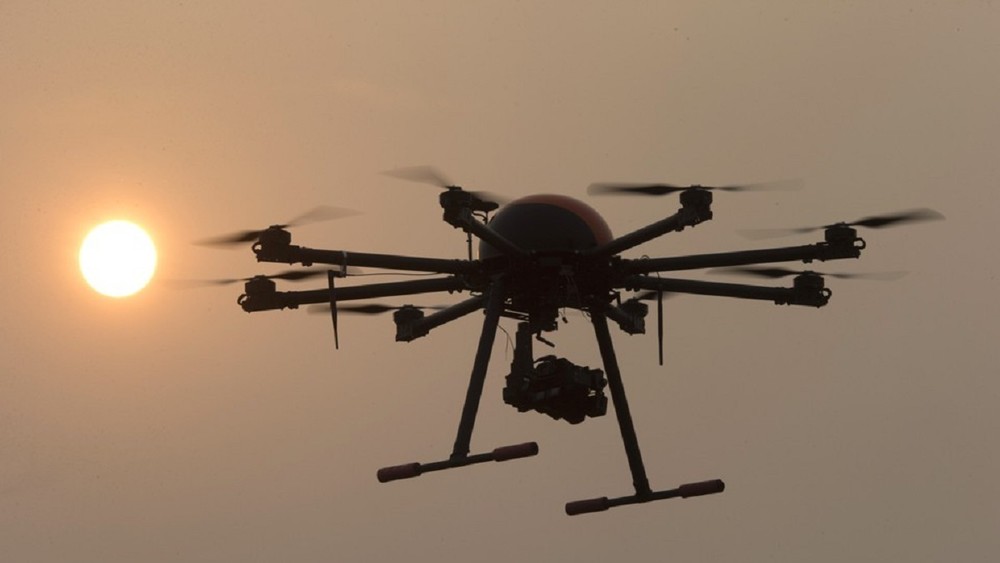
Instead of lugging around 30-pound counter-drone equipment, some security forces airmen will soon have a 5-pound device they can use to jam weaponized drones from the enemy.
The Air Force purchased 100 handheld Dronebuster devices, according to Clay Wild, vice president of marketing for Radio Hill Technologies, a Portland, Oregon-based technology startup that completed the contract for the Air Force.
The company worked with the Air Force’s Installation Contracting Agency on the $2.5 million purchase.
The use of weaponized drones by the Islamic State has been a rising concern for the past year or two. ISIS drones are now attacking U.S. Special Operations forces around Raqqa, Syria, as U.S.-backed Syrian Defense Forces attempt to liberate the militants' self-proclaimed capital, according to a report Wednesday in The Washington Post.
The Dronebuster can detect incoming radio frequency signals, which helps troops aim the device in low visibility. It can jam consumer and modified drone radios in several frequency bands, and the five custom antennae provide directional jamming over longer ranges, he said.
Wild said the company Radio Hill Technologieswill start delivering the Air Force systems in July, and then the company will train Air Force trainers on how to use the devices so they can train their airmen.
“There’s a little bit of classroom time that is warranted for the airmen to understand the radio frequency spectrum, how jammers work, what radio frequencies the drones are flying on versus regular communications versus other systems,” he said.
The classroom time and practice will only be a few hours, and the device itself is easy to use, Wild said.
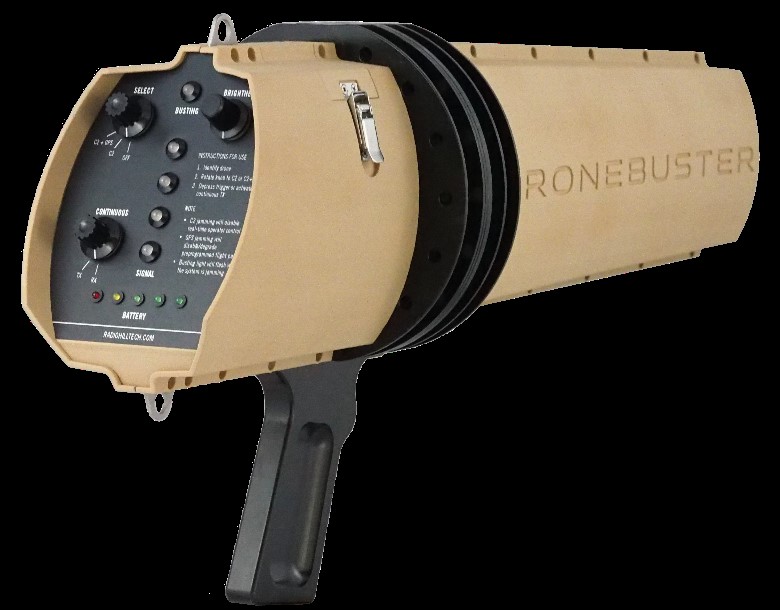
Air Force Dronebuster
Radio Hill Technologies will start delivering 100 Dronebusters to the Air Force in July, and then train airmen on how to use the devices. Photo Credit: Courtesy of Radio Hill Technologies I
The Dronebuster, which starts at $30,000, has a “technique generator” that uses less than 10 percent of the battery power for the jamming signal. This allows the device to be smaller than other similar devices.
Most jamming tools are mounted on a rifle, with the jamming antennae stuck on the end of the rifle butt, Wild said. The power is kept in a backpack, and the whole system weighs about 30-40 pounds.
That’s a pretty big unit for airmen or soldiers to carry,” he said. “If any security forces personnel were going to deploy anything, it had to be really small.”
Anything smaller than 5 pounds is tough, Wild said, because the antennae must be a certain size.
Air Force Times
'If you can't talk, you can't fight': Compass Call planes confuse ISIS
Security forces with Air Force Global Strike Command will use the devices at a “variety of sites,” according to an emailed response the Air Force sent to Air Force Times.
“Countering the threat that small, unmanned aircraft systems pose, whether in the hands of hostile forces or negligent actors, is vital to ensuring continued air superiority and protecting U.S. personnel,” the statement said. “The Air Force identified the Dronebusters as an immediately available, off-the-shelf option to aid the Air Force in countering the emerging hostile threat posed by small, unmanned aircraft systems.”
The Air Force said they couldn’t release further details because of security reasons.
The Army's Rapid Equipping Force bought 50 Dronebusters in April.
Charlsy Panzino covers the Guard and Reserve, training, technology, operations and features for Army Times and Air Force Times. Email her at This email address is being protected from spambots. You need JavaScript enabled to view it..
Airman of the Year Saves Lives, Prepares New Airmen for Service
By: Stephen Losey, AF Times, June 27, 2017 (Photo Credit: Andrew C. Patterson/Air Force)
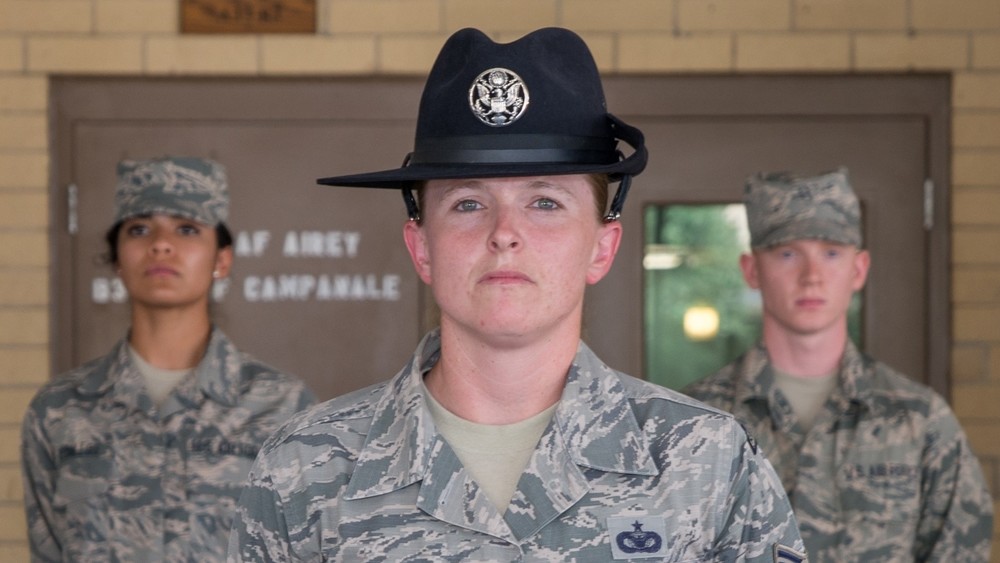
Saving one person’s life usually is enough to establish someone as a hero.
Tech. Sgt. Megan Harper saved two lives in a single evening.
Harper is Air Force Times’ 2017 Airman of the Year due to her nearly 15 years of service excellence — from the battlefields of Iraq as a security forces airman, to her devotion to producing outstanding young airmen as a Military Training Instructor, to serving her community and saving lives at home.
Harper’s flight commander, Maj. Christopher Sweeney, said her passion and enthusiasm have made her respected by all as she trains and inspires her basic trainees. She leads from the front, with compassion, and doesn’t hesitate to do as much as she asks of her trainees.
“She’s an instructor who’s going to get out there and do it with you,” Sweeney said. “If it’s time to get down and do some push-ups, she’s going to get down and do them with you. She’s going to lead you through them.”
Harper, of Mesquite, Texas, is the child of two soldiers — her mother was in the medical field, and her father was a personnelist. She joined the Air Force in November 2002, after the Sept. 11 attacks because, she said, “It was my turn to serve
“It was something that I was moved to do, and … be a part of that initiative to take that fight downrange as opposed to having it here on American soil,” Harper said. “When I went to the recruiter, they asked me what I wanted to do, and I said, ‘I just want to kill terrorists.’ And they looked at me and said, ‘Oh, we have the job for you,’ and told me that security forces, if I wanted to deploy and have a weapon and get into the fight, that was going to be my best chance there.”
The recruiters steered Harper right, she said. She deployed five times — first to Kirkuk, Iraq, in fall 2003 for six months, and later to Balad, Iraq; Kuwait twice; and Manas, Kyrgyzstan.
'Constant action, constant alert'
In Kirkuk, Harper and her fellow airmen provided airbase defense, securing the perimeter and the entries to facilities. It was intense and dangerous, Harper said. Her base was mortared several times, and she was involved in firefights.
“Definitely grew me up,” Harper said. “It was almost constant action, and on constant alert. [But] I was actually more amped up to be part of the mission, as opposed to actually fearing anything.”
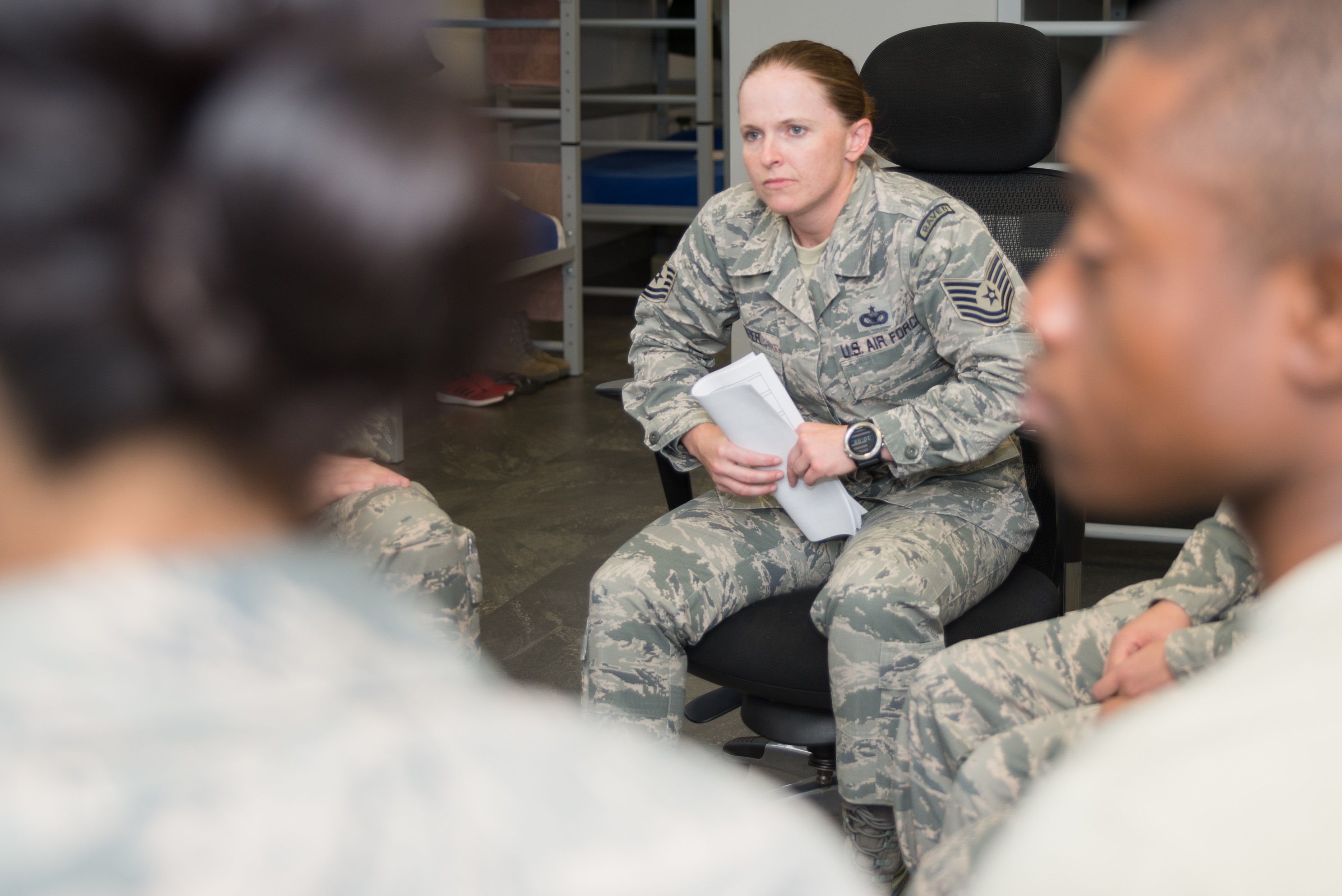
Tech. Sgt. Megan Harper leads a small group discussion with airmen in basic military training. Photo Credit: Andrew C. Patterson/Air Force
In May 2004, Harper became the ninth woman in Air Force history to finish the elite security forces Phoenix Raven program, which specially trains airmen to provide security on-board aircraft while in flight — such as protecting the cockpit when foreign nationals are on board — and provide ground security when those airplanes land in dangerous areas. That training program was intensely physical, she said, teaching hand-to-hand combat and baton techniques, as well as undergoing air marshal training.
In 2014, Harper became an MTI and said it was the “absolute best decision I’ve ever made in my career.”
Today, she said, she doesn’t see the same “call to service” that there was right after 9/11. So when a young man or woman decides to take the oath and serve, she’s honored to help them become airmen.
“It’s incredibly important that we teach and we train and we mentor and inspire our replacements, because that’s who we’re handing the security of our nation over to in the future,” Harper said. “I’m incredibly humbled to be able to do that every day — to take someone from a civilian and teach them what it is to serve by that oath, and encompass and embody core values and commitment to service.”
Harper has trained 1,125 new airmen and graduated 22 flights since she became an MTI at Joint Base San Antonio-Lackland in Texas.
Recently, Sweeney said, Harper was named a master military training instructor and received the blue rope showing she is among the top 10 percent of MTIs in the Air Force.
She also oversees 14 other instructors as an interim instruction supervisor — the only one in her unit who is not a master sergeant, although earlier this year she was selected for E-7. That promotion will take her past 20 years of service, though she wants to stay in uniform as long as possible.
“They’re going to have to force me out,” Harper said.
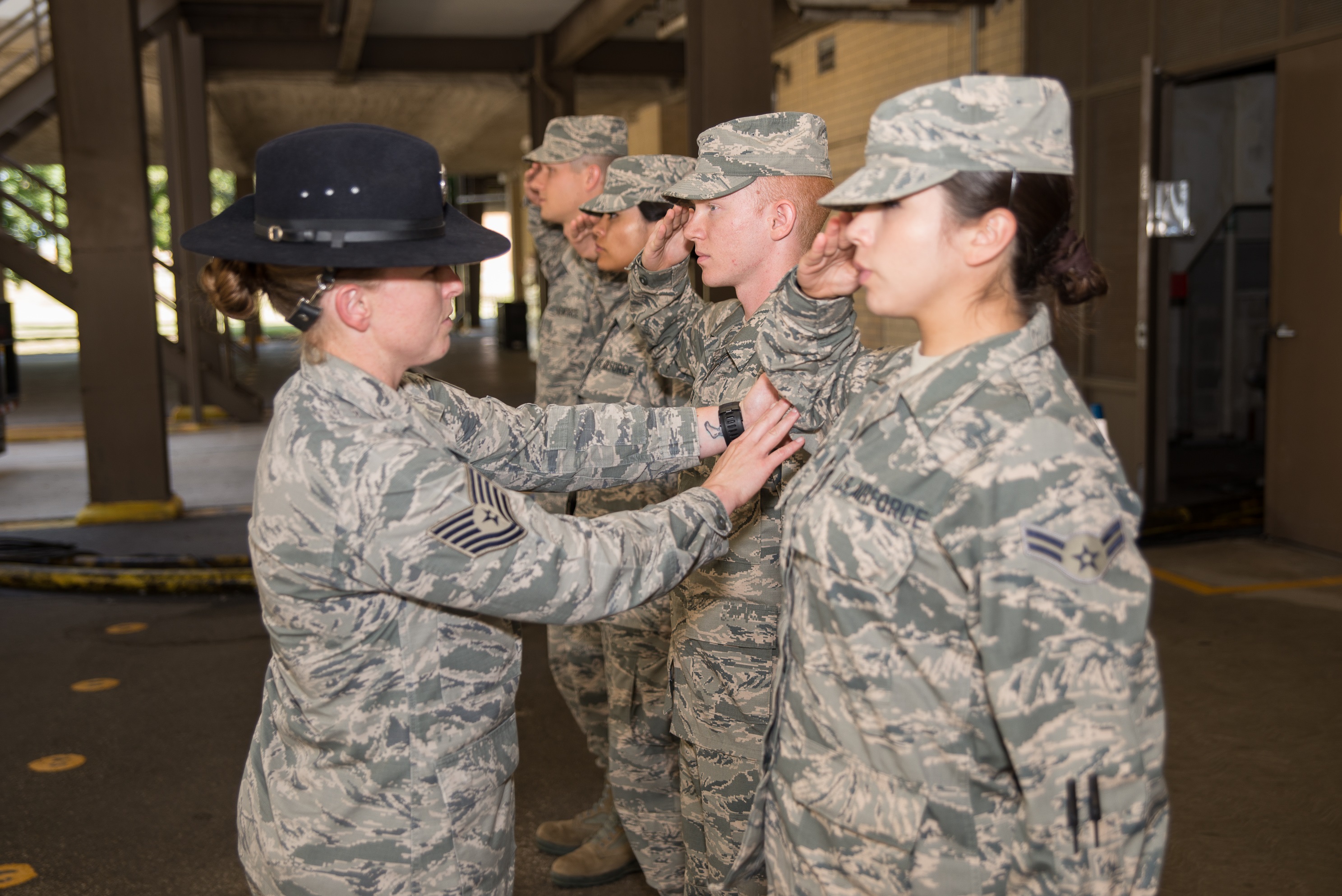
Tech. Sgt. Megan Harper, a military training instructor, works with airmen on Joint Base San Antonio-Lackland, Texas. Harper is the 2017 Airman of the Year. Photo Credit: Andrew C. Patterson/Air Force
Saving lives
On May 9, 2016, Harper’s quick thinking and dedication saved the lives of two people in separate incidents.
First, she performed the Heimlich maneuver on a trainee who began choking in the dining facility at Lackland. Another trainee motioned to the instructors' table that the choking trainee needed help, and Harper and another instructor responded. The trainee was holding his neck and turning blue, Harper said, so she told him to stand up and that she was going to perform the Heimlich maneuver. She dislodged the stuck food with three forceful thrusts, and the trainee was fine.
Less than three hours later, as she was leaving base, Harper saw a pedestrian who had been struck by a motor vehicle and stopped to help. The young woman’s breathing and heart rate were shallow, she said, so Harper sprung into action.
She went back to her car and grabbed gloves, dressing and a few bandages, and light-up discs to set up around the area and redirect traffic. She then started to perform first aid. She took off her ABU blouse, balled it up, and slid it under the victim’s head to keep her stable in case her spine or neck was injured.
The victim was bleeding profusely from the back of her head, which was also swelling severely, so Harper applied pressure to try to stop the bleeding. When Harper was silent, the victim would start to violently shake, so she kept talking to the victim to calm her down, reassure her that an ambulance was coming, and kept her from going into shock.
Harper followed the ambulance to the hospital and waited until about 2:30 in the morning in case they got in touch with the woman’s family, so she could tell them what happened. Harper knows the woman survived the night and was in critical condition, but because of privacy rules, she never found out what happened to her afterwards.
For her actions, Harper received the Air Force Achievement Medal — though Sweeney said that due to Harper’s humility, other airmen had to drag the details of the incidents out of her.
Harper is also heavily involved in volunteer activities that support veterans, such as the Bataan Death March memorial race and drives to collect hygiene supplies for female veterans in San Antonio and uniforms for junior ROTC cadets.
She also works with Team Rubicon, a veterans organization that responds to natural disasters such as tornadoes and flooding, and programs to help underprivileged youth like the Juvenile Justice Center, an alternative school for at-risk young people who have been kicked out of school.
Harper also heads up a mentorship program for young LGBT troops coming in to the military. And later in June, Harper is scheduled to brief a two-star general on implementing transgender policies at basic training.
“She is knowledgeable, she is approachable, credible, all of those professionalism pieces you look for, that’s her,” Sweeney said. “She’s just hungry for it. She just really wants to be the best airman she could be.”
Schriever IMA Selected for Vital Command
By Airman William Tracy, 50th Space Wing Public Affairs, Published February 15, 2017 SCHRIEVER AIR FORCE BASE, CO

Lt. Col. Marcus Corbett, 50th Security Forces Squadron Individual Mobilization Augmentee to the commander, will soon command full time at one of the Air Force’s preeminent installations.
Corbett will be adopting a new role as 10th Security Forces Squadron commander at the U.S. Air Force Academy. While the IMA program provides the tools for reservists to operate in an active-duty environment, Corbett’s role differs from most IMA functions. He has been specially selected, among other candidates, to command an active-duty squadron, a rarity for the program.
Corbett was one of only five IMAs to make the candidate list.
“For an IMA to be selected, let alone meet the candidate list, is a big deal,” said Lt. Col. Michael Speck, 50 SFS commander, who knows firsthand the effectiveness of Corbett’s leadership through the IMA program, where he served in his place in times of absence. “Not all active-duty security forces officers are selected to command and it is a competitive process. For an IMA to be selected is an achievement, especially for a high profile unit such as the Academy.”
Corbett said he is excited to lead security personnel at the Academy, accepting the challenge of maintaining safety for an area which often hosts massive family gatherings, contingents of senior ranking officers and the president himself.
“It’s the most secure open base in the Air Force,” said Corbett. “There’s concerts, football games and athletic events. Then there’s events like Corona were generals across the Air Force show up, and graduation and parents weekend, where tens of thousands of people come into the base for a short period of time who don’t have identification or credentials. So, the challenge is conducting these happenings in an efficient process, while protecting the assets of the base.”
Corbett hopes to learn from the Airmen as well as share his expertise with them to help maintain the security of the base.
“The beautiful thing is that I will have a squadron full of Airmen and personnel who have approached this challenge, and succeeded significantly at it,” said Corbett.
Speck is not surprised Corbett was selected to lead a major squadron such as the 10 SFS.
“While I was TDY (Tour of Duty), he did a superb job leading the unit and communicating with the group and wing commander,” said Speck. “With the way the military has been heading in recent years, we rely more and more on our Reserve forces. Lieutenant Colonel Corbett is an outstanding officer and graduated commander in the Reserve force, and he will lead the 10 SFS extremely well paving the way for other active-duty command opportunities for reservists in the future.”
The transition from Reserve to active duty can be difficult, but Corbett, who served on active duty for 11 years prior to going Reserve, is ready to embrace the lifestyle once again.
“I am looking forward to it,” said Corbett. “The thing that I miss the most (about active duty) was being around Airmen on a daily basis. As a reservist, you have limited time at the unit.”
The Academy is not an entirely new area for Corbett. A former graduate, it’s a return to familiar territory, although he said the base has changed.
“They have some new structures and upgrades,” said Corbett. “They are constantly improving the infrastructure. Though there are still little things that bring back memories.”
While his upcoming command approaches, Corbett and the Schriever Airmen he served with will not forget the memories and friendships made during his time here.
“I’ve enjoyed Schriever, loved how it was quiet and secluded in a way,” said Corbett. “The 50th Security Forces Squadron is a great unit. From senior leadership all the way down to the Airmen. They have some phenomenal people, they are very professional and I thoroughly enjoyed my time here.”
Speck is confident Corbett will continue to make a positive impact at the Academy.
“I’m sure he’ll find success, he will do a great job over there,” said Speck. “I’ve met many officers and enlisted, both active-duty and Reserve over the years, and I can definitely tell you that Lieutenant Colonel Corbett is a stellar officer.”
Changes of Commands at the 377SFG at Kirtland AFB, NM
By Dave Coulie
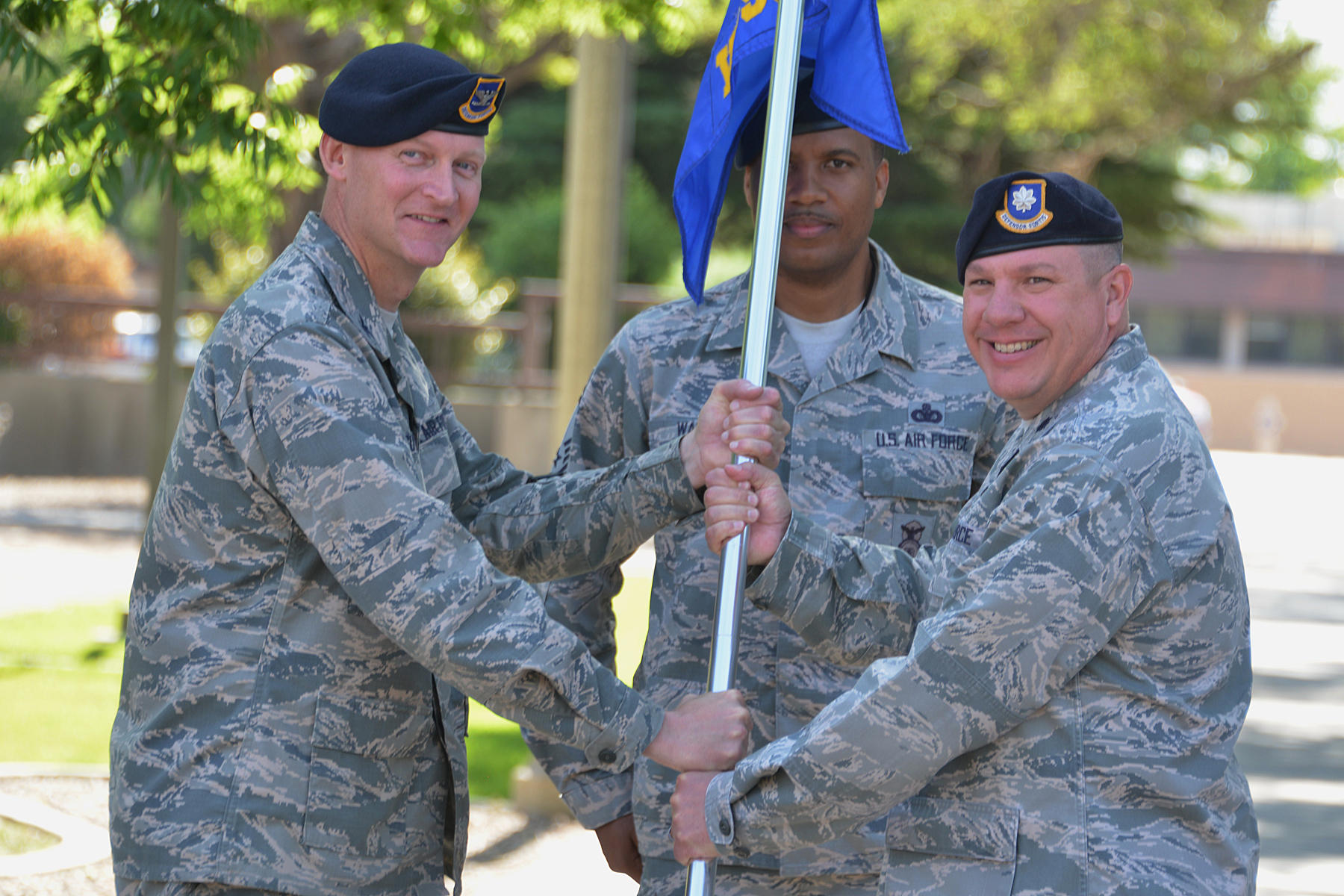
377 SFG Commander, Colonel Dustin Sutton passes the unit guidon to incoming 377WSSS Commander Lt Col Joseph (Jay) Parsons at Change of Command ceremony on 8 June 2017 at Kirtland AFB, NM. Lt Col Jay Meier is outgoing commander. Guidon bearer is CMSGT Clayton Watson.

377 SFG Commander, Colonel Dustin Sutton passes the unit guidon to incoming 377 Security Support Squadron Commander Major David Bullock at Change of Command ceremony on 20 June 2017 at Kirtland AFB, NM. Major Eric Judd is outgoing commander. Guidon bearer is SMSGT Regina Bailey.

377 SFG Commander, Colonel Dustin Sutton, accepts the unit guidon from outgoing 377 Security Support Squadron Commander, Major Eric Judd, at Change of Command ceremony on 20 June 2017 at Kirtland AFB, NM. The following day at another Change of Command Major Judd became commander of the 377 SFS replacing outgoing commander Major Brenton Pickrell. Guidon bearer is SMSGT Regina Bailey.
In the month of June 2017 the 377th SFG at Kirtland AFB held Change of Command ceremonies for all three of its component units. Members of the Pete Magwood (New Mexico) Chapter attended all three ceremonies and were recognized and honored by the SFG Commander and all departing commanders for the great partnership between the Units and the Chapter. The Chapter members thanked the outgoing commanders for their strong support and warmly welcomed the new commanders."
Page 33 of 50


